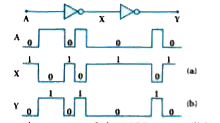Carbon, silicon and germanium have four valence electrons each. These are characterised by valence and conduction bands separated by energy band gap respectively equal to . Which of the following statements is true?Solution in Gujrati
The correct Answer is:C
Among the given elements the band gap of Si and Ge is 5.4 eV, 1.1 eV and 0.7 eV respectively. Hence, option (c ) is correct.
Topper's Solved these Questions
- BOOK - KUMAR PRAKASHANCHAPTER - SEMICONDUCTOR ELECTRONICS : MATERIALS, DEVICES AND SIMPLE CIRCUITS EXERCISE - Section-B : Numericals (Numerical From .DARPAN. Based On Textbook)14videos
SEMICONDUCTOR ELECTRONICS : MATERIALS, DEVICES AND SIMPLE CIRCUITS
- BOOK - KUMAR PRAKASHANCHAPTER - SEMICONDUCTOR ELECTRONICS : MATERIALS, DEVICES AND SIMPLE CIRCUITS EXERCISE - Section-C: NCERT Exemplar Solution (Multiple Choice Qustion (MCQs) )8videos
SEMICONDUCTOR ELECTRONICS : MATERIALS, DEVICES AND SIMPLE CIRCUITS
- BOOK - KUMAR PRAKASHANCHAPTER - SEMICONDUCTOR ELECTRONICS : MATERIALS, DEVICES AND SIMPLE CIRCUITS EXERCISE - Section-B : Numericals (Numerical From Textual illustrations)16videos
SEMICONDUCTOR ELECTRONICS : MATERIALS, DEVICES AND SIMPLE CIRCUITS
- BOOK - KUMAR PRAKASHANCHAPTER - SAMPLE QUESTION PAPER EXERCISE - PART-B SECTION-C5videos
SAMPLE QUESTION PAPER
- BOOK - KUMAR PRAKASHANCHAPTER - WAVE OPTICSEXERCISE - SECTION-D (MULTIPLCE CHOICE QUESTIONS (MCQS)) (MCQS FROM DARPAN BASED ON TEXTBOOK)239videos
WAVE OPTICS
Similar Questions
A logic circuit is shown in the diagram. Draw the output signal at the point X and Y for the input signal shown in the figure at point A.
 02:04View Solution
02:04View SolutionThe conductivity of a semiconductor increases with increase in temperature because
01:51View SolutionC, Si and Ge have same lattice structure. Why is C insulator while Si and Ge intrinsic semiconductors?
03:51View SolutionTwo charges –q and +q are located at points (0, 0, –a) and (0, 0, a), respectively.
(a) What is the electrostatic potential at the points (0, 0, z) and (x, y, 0) ?
(b) Obtain the dependence of potential on the distance r of a point from the origin when r/a>>1 .
(c) How much work is done in moving a small test charge from the point (5,0,0) to (–7,0,0) along the x-axis? Does the answer change if the path of the test charge between the same points is not along the x-axis?02:12View SolutionAccording to particle theory of light what is the velocity of light in a dense medium, compared to that in rare medium ?
04:48View SolutionCarbon , silicon and germanium have four valence elcectrons each . These are characterised by valence and conduction bands separated by energy band - gap respectively equal to (Eg)c(Eg)si and (Eg)Ge. Which of the following statements ture ?
01:51View SolutionCarbon, silicon and germanium atoms have four valence electrons each. Their valence and conduction bands are separated by energy band gaps represented by (Eg)C,(Eg)Si and (Eg)Ge, respectively. Which one of the following relationship is true in their case?
01:51View Solutionकार्बन, सिलिकॉन और जर्मेनियम, प्रत्येक में चार संयोजक इलेक्ट्रॉन हैं। इनकी विशेषता ऊर्जा बैंड अंतराल द्वारा पृथक्कृत संयोजकता और चालान बैंड द्वारा दी गई है जो क्रमश: (Eg)C,(Eg)Si
01:50View SolutionCarbon, silicon and germanium have four valence electrons each. These are characterised by valence and conduction bands separated by energy band gap respectively equal to ( E _(g))_(c ) , ( E_(g))_(Si ) and ( E_(g ))_(G e ) .Which of the following statements is true ? (a) (E_(g))_(Si) lt ( E_(g))_(Ge ) lt ( E_(g))_(C ) (b) ( E_(g))_(C ) lt ( E_(g))_(Ge ) gt (E_(g))_(Si) (c ) (E_(g))_(C ) gt ( E_(g))_(SI) gt ( E_(g))_(Ge ) (d) ( E_(g))_(C ) = ( E_(g))_(Si) = ( E_(g))_(Ge )
05:11View SolutionCarbon silicon and germanium have four valence electrons each. These are characterised by valence and conduction bands separated by energy band gap respectively equal to (E_(g))_(C), (E_(g))_(Si) " ""and" " "(E_(g))_(Ge) which of the following statements is true?
View SolutionCarbon, silicon and germanium atoms have four valence electrons each. Their valence and conduction bands are separated by energy band gaps represented by (Eg)C,(Eg)Si and (Eg)Ge, respectively. Which one of the following relationship is true in their case?
04:21View SolutionCarbon, silicon and germanium atoms have four valence electrons each. Their valence and conduction bands are separated by energy band gaps represented by (Eg)C,(Eg)Si and (Eg)Ge, respectively. Which one of the following relationship is true in their case?
View SolutionCarbon silicon and germanium have four valence electrons each these are characterised by valence and conduction bands separated by energy band gap respectively equal to which of the following statement is true
(a) (Eg)Si<(Eg)Ge<(Eg)c
(b)(Eg)c<(Eg)Ge<(Eg)Si
(c )(Eg)c>(Eg)Si>(Eg)Ge
(d)(Eg)c=(Eg)si=(Eg)Ge02:16View SolutionCarbon, silicon and germanium have four valence electrons each . These are characterised by valence and conduction bands separated by energy band gap respectively equal to (Eg)C,(Eg)Si and (Eg)Ge . Which of the following statements is true ?
01:23View SolutionCarbon, silicon and germanium have four valence electrons each. These are characterised by valence and conduction bands separated by energy band gap respectively equal to (E_(g))_(C),(E_(g))_(Si) and (E_(g))_(Ge) . Which of the following statements is true?
01:37View Solution

